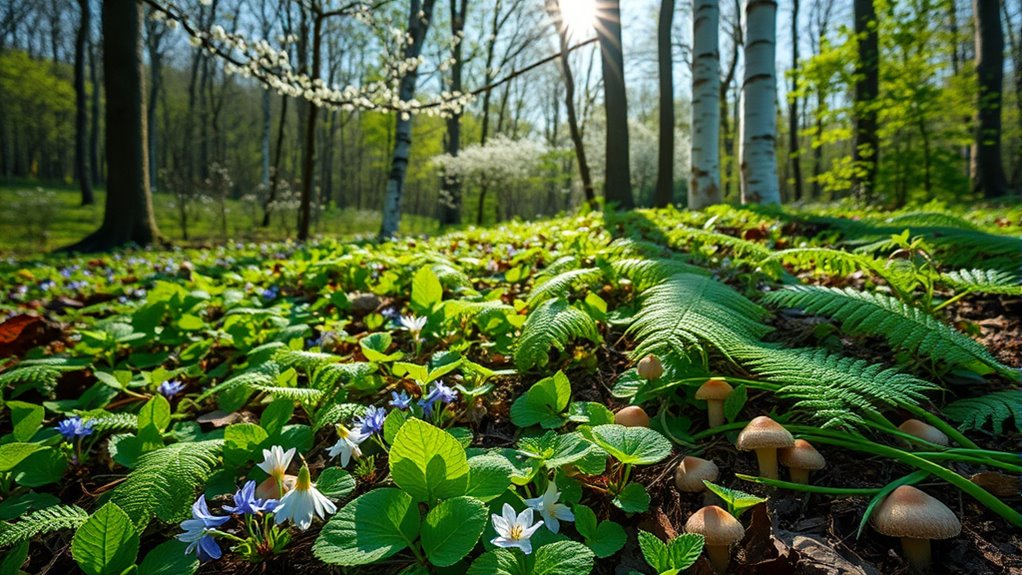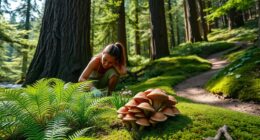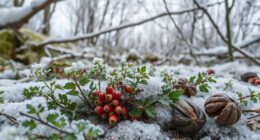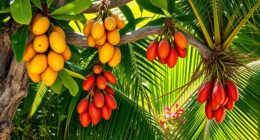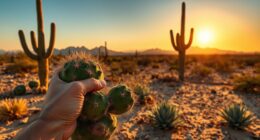In spring, you can forage for tender greens like chickweed, dandelion, and clover, which are perfect for salads and teas. You’ll also find wild mushrooms such as morels and oysters, along with vibrant wildflowers like violets and edible shoots like wild asparagus. Don’t forget nutritious greens like stinging nettle or medicinal plants like yarrow. By identifying plants responsibly and learning safe harvesting methods, you’ll uncover the season’s best flavors and health-boosting treasures — keep exploring to find out more.
Key Takeaways
- Identify and harvest early spring greens like chickweed, dandelion, and clover for nutritious salads, teas, and flavorings.
- Forage invasive plants such as garlic mustard and field garlic to support ecological balance and enjoy flavorful culinary uses.
- Seek out seasonal wild mushrooms like morels, oysters, and boletes, ensuring accurate identification and proper cooking.
- Collect wild flowers, shoots, and medicinal herbs like violets, wild asparagus, yarrow, and plantain to enhance dishes and health remedies.
- Practice sustainable foraging by verifying plant ID, harvesting responsibly, respecting regulations, and connecting with local experts and resources.
Early Spring Greens: Chickweed, Dandelion, and Clover
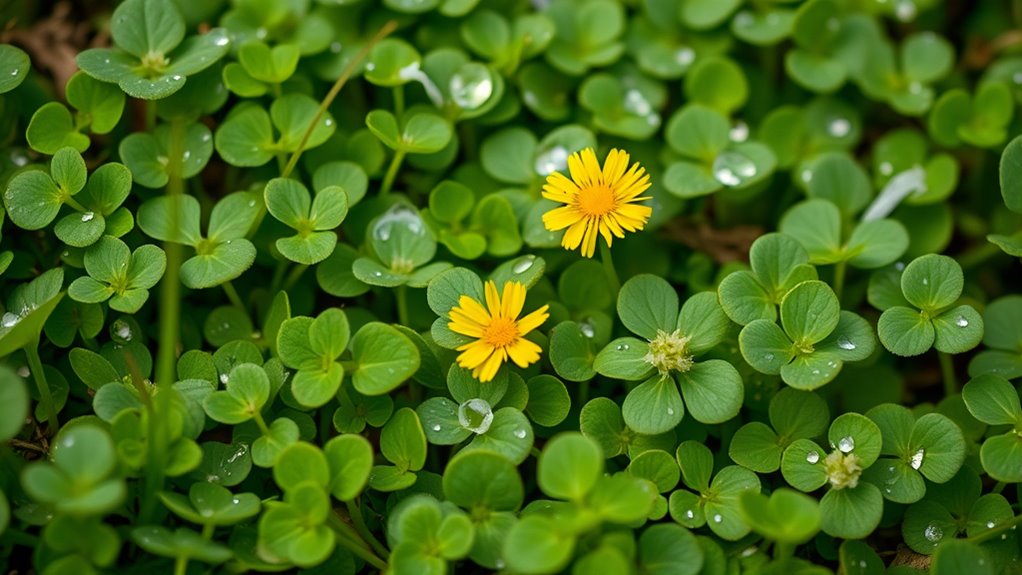
Early spring is the best time to harvest tender, nutrient-rich greens like chickweed, dandelion, and clover before they develop bitterness or mature flavors. These early spring greens are prime wild edibles, offering a bounty of edible plants packed with nutrients. Chickweed, with its mild flavor, thrives in disturbed soils and is perfect for salads or pesto. Dandelion provides tender leaves and bright yellow flowers, while its roots can be roasted for herbal tea—best before they turn bitter. Clover, including white and red varieties, is sweet and tender, often used in teas, salads, or as honey flavoring. Foraging these greens now ensures you enjoy their peak flavor and nutrient density while supporting sustainable harvesting practices. Early spring greens are a crucial part of any wild edible collection. Additionally, harvesting these greens at their peak helps preserve their nutritional value, ensuring you get the most health benefits from your foraged foods.
Notable Invasive Edibles: Garlic Mustard and Field Garlic
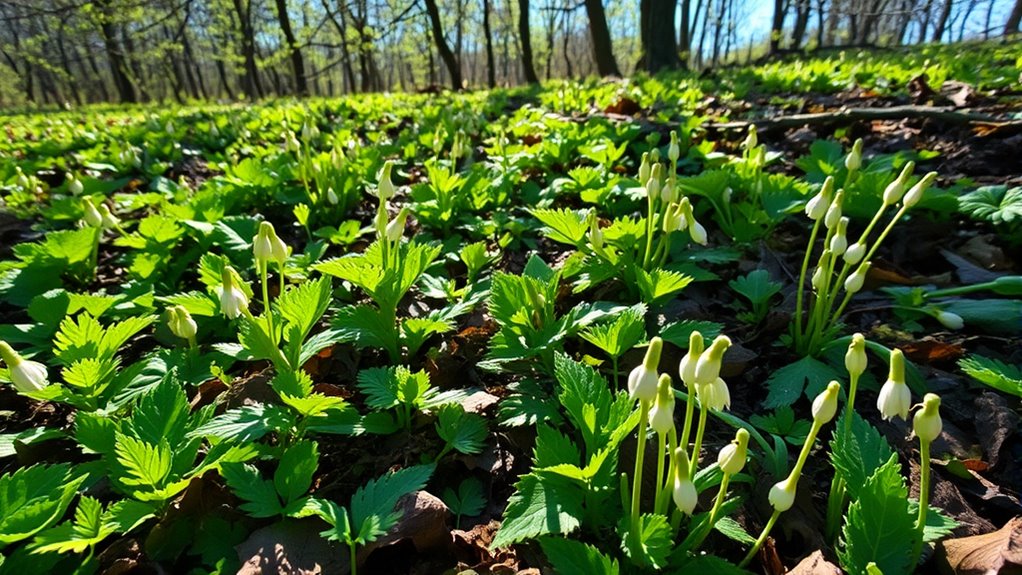
Invasive edibles like garlic mustard and field garlic offer nutritious, flavorful greens that can enhance your spring dishes. Harvesting these plants helps control their spread and supports local ecosystems. By foraging responsibly, you turn a problem into a tasty solution while promoting ecological balance. Additionally, understanding their foraging range ensures you harvest sustainably without impacting surrounding native species.
Benefits of Invasive Edibles
Harvesting invasive edibles like garlic mustard and field garlic offers a practical way to reduce their spread while providing nutritious, flavorful additions to your meals. By foraging these invasive plants, you help control their spread and support ecosystem benefits, such as preserving native biodiversity. Both garlic mustard and field garlic are considered edible weeds, making them excellent options for spring foraging. Their medicinal herb qualities and culinary versatility allow you to incorporate them into pestos, salads, and flavorings. Sustainable harvesting of these invasive plants not only diminishes their dominance but also transforms a problem into an opportunity for healthy eating. Embracing these invasive edibles turns a challenge into a benefit, fostering a more balanced, resilient local ecosystem. Additionally, understanding the role of contrast ratio in projectors can help you create optimal viewing environments for appreciating these natural wonders. Incorporating tuning techniques from automotive practices can also inspire innovative ways to approach sustainable foraging and ecosystem management, such as using adaptive management strategies to monitor invasive species populations effectively. Engaging in community-led efforts can further enhance the impact of invasive species control and promote biodiversity conservation.
Culinary Uses and Flavors
Garlic mustard and field garlic offer distinctive flavors that can elevate your cooking, making them excellent choices for foraging. These wild edibles bring unique wild flavors to your dishes, from pestos and salads to sautés. As invasive plants, they’re often plentiful along woodland edges and disturbed areas, perfect for spring foraging before they become too mature and bitter. Incorporating garlic mustard adds a roasted garlic note, ideal for flavoring dips or pasta, while field garlic’s tender bulbs and onion-scented leaves work well in soups or as a garnish. Harvesting these edible weeds supports sustainable harvesting practices, helping control their spread while enriching your meals. Using invasive plants in your culinary uses not only enhances taste but also promotes ecological balance through mindful harvesting. Additionally, vibrational energy plays a role in the abundance of foraging opportunities, encouraging a positive mindset that attracts more natural bounty. Understanding native plant ecology can further enhance your foraging success by helping you identify the best harvesting locations and times. Moreover, practicing mindful foraging ensures that these plants are harvested sustainably and responsibly, preserving local ecosystems for future foragers. Connecting with wild plant identification techniques can also improve your confidence and accuracy when foraging for these invasive species, especially when considering plant growth cycles to determine the optimal harvest time.
Ecological Impact and Control
Utilizing garlic mustard and field garlic in your foraging not only provides flavorful, nutrient-rich greens but also plays a role in managing their spread. These invasive species threaten native plants and disrupt ecosystem health by outcompeting local flora. Ecological management through foraging control helps reduce their dominance and supports habitat restoration efforts. Regular invasive plant removal by harvesting these greens encourages native plant growth and maintains balanced ecosystems. Sustainable harvesting ensures you’re not encouraging regrowth of invasive plants while benefiting from nutritious food sources. By removing garlic mustard and field garlic, you actively contribute to invasive species control and promote healthier habitats. Your foraging efforts help restore native biodiversity and support long-term ecosystem stability.
Spring Wild Mushrooms: Morels, Oysters, and Boletes

As spring arrives, foragers enthusiastically seek out three prized wild mushrooms: morels, oysters, and boletes. These spring wild mushrooms are highlights of the seasonal harvest, but accurate mushroom identification is crucial to avoid toxic look-alikes. Morel mushrooms (Morchella spp.) have a honeycomb cap and appear from late April to early June, demanding careful foraging. Oyster mushrooms (Pleurotus ostreatus) grow on decaying wood, recognizable by their fan-shaped, pale caps and white gills. Boletus, or porcini, emerge under conifers with thick brown caps and olive-green pores. Proper cooking is essential for all edible fungi, especially morels. Timing and climate influence their abundance, so quick and precise foraging ensures a safe, delicious harvest. Online resources can provide additional guidance for identifying safe mushrooms and avoiding dangerous look-alikes. It is also important to know seasonal patterns to maximize the chances of finding these mushrooms at their peak. Being aware of mushroom identification techniques helps ensure a successful and safe foraging experience.
Edible Wild Flowers and Shoots: Violets, Wild Asparagus, and Fiddleheads
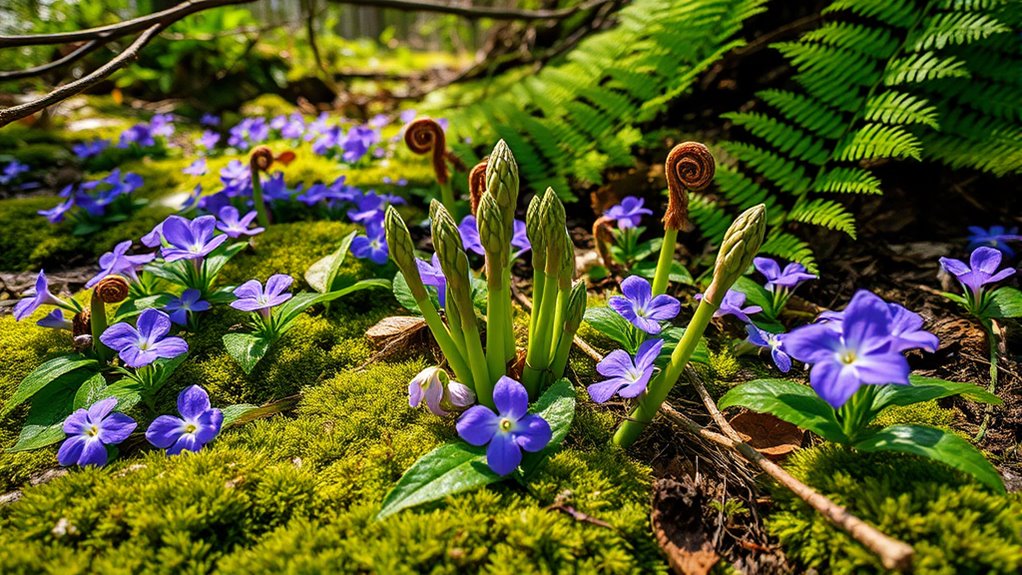
With spring wild mushrooms making their appearance, it’s the perfect time to turn your attention to the vibrant wild flowers and shoots that also emerge during this season. During spring foraging, you’ll find edible wildflowers like wild violets, which bloom early and add color to salads or vinegar infusions, and also offer medicinal benefits. Wild asparagus appears as tender, spear-like shoots along fence lines and woodland edges, providing a delicious early spring green. Fiddlehead ferns, the curled young fronds of ostrich fern, emerge in spring and have a flavor similar to green beans or asparagus, but must be cooked thoroughly before eating. Harvesting these wild edibles sustainably supports local ecosystems while bringing fresh, nutrient-dense ingredients to your wild foraged meals. Foraging techniques are essential to ensure safe and responsible harvesting practices.
Nutritious Wild Greens: Stinging Nettle, Dead Nettle, and Henbit
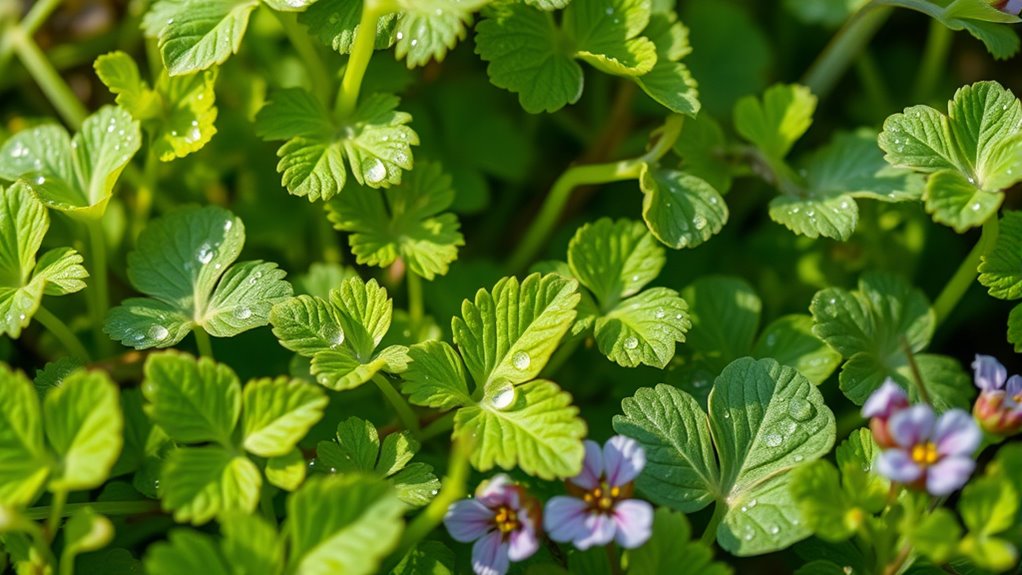
Wild greens like stinging nettle, dead nettle, and henbit offer impressive nutritional benefits and are versatile in your foraging kitchen. Learning to identify these plants correctly and understanding how to harvest them guarantees you get the most nutrition while staying safe. Starting with young leaves in early spring maximizes flavor and nutrient content, making your foraging efforts worthwhile.
Nutritional Benefits and Uses
Stinging Nettle, Dead Nettle, and Henbit are highly nutritious wild greens that can boost your health in many ways. As wild edibles, these seasonal plants provide impressive nutritional benefits, making them valuable additions to your diet. When foraging, you’ll find that stinging nettle offers a dense source of vitamins A, C, K, calcium, iron, magnesium, and antioxidants, supporting immune function and energy. Dead Nettle and Henbit are rich in vitamins A and C, perfect for salads, pestos, and herbal remedies. These wild foods are versatile, offering health benefits that surpass many cultivated greens. Incorporating these greens into your meals helps you enjoy the following:
- Natural source of essential nutrients
- Supports immune health
- Boosts energy levels
- Adds variety to your diet
- Promotes sustainable eating
Additionally, their easy identification makes foraging safe and accessible for beginners. Understanding wild edible plants and their nutritional profile enhances your ability to forage confidently and responsibly, especially as knowledge about AI in Education continues to grow and adapt to new technologies. Exploring the sound vibrations used in sound therapy can deepen your appreciation for holistic health practices.
Identification and Harvesting Tips
Identifying and harvesting these nutritious greens correctly guarantees you get the most benefit while staying safe. For stinging nettle, recognition comes from its serrated, heart-shaped leaves and fine hairs that cause a stinging sensation—wear gloves when harvesting. Focus on young leaves, which are tender and ideal for eating. Dead nettle resembles stinging nettle but lacks stinging hairs; look for purple-tinged, scalloped leaves with pink or purple flowers. Henbit is a low-growing herb with rounded, scalloped leaves and small purple flowers. These edible greens are abundant in spring and offer essential nutrients. Practicing sustainable foraging by harvesting only what you need and leaving enough wild plants to regenerate is crucial. Proper identification and thoughtful harvesting tips ensure safe, delicious spring greens while preserving the environment. Additionally, understanding foraging safety tips can help prevent accidental ingestion of inedible or harmful plants.
Medicinal Plants in Bloom: Willow, Yarrow, and Plantain
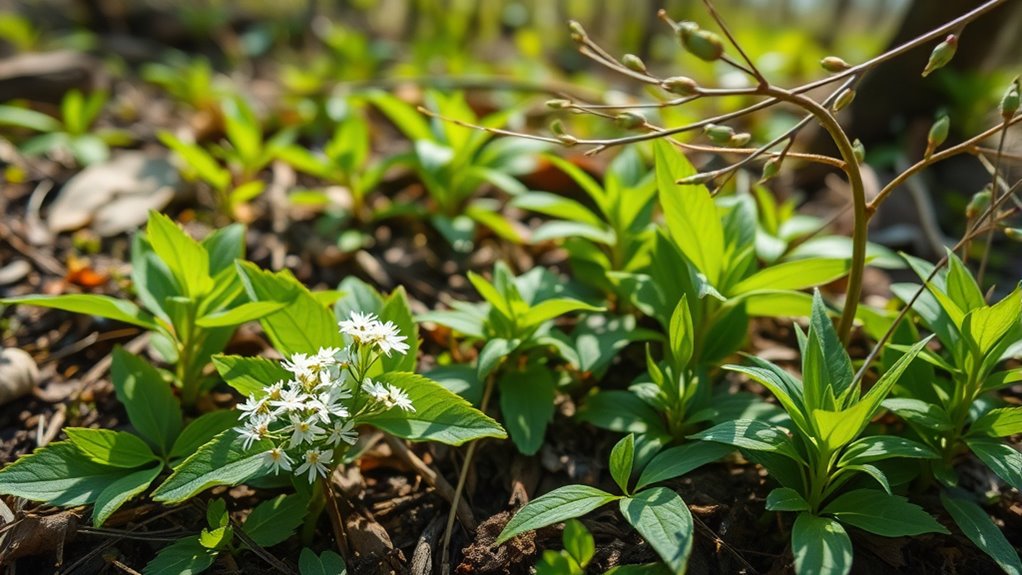
As spring arrives, the blooming of medicinal plants like willow, yarrow, and plantain offers a valuable opportunity for foragers to gather natural remedies. During this early spring, you can find these plants in full bloom, providing fresh sources for herbal remedies. When harvesting, focus on sustainable practices to guarantee their continued availability. Utilizing predictive analytics can help identify optimal harvesting times based on environmental data, ensuring the plants’ health and abundance. Recognizing the ideal harvesting season is essential for maintaining the potency and effectiveness of these herbal remedies.
- Willow bark contains salicin, effective for pain relief and fever reduction
- Yarrow helps treat fevers, colds, and bleeding with its anti-inflammatory properties
- Plantain soothes bites, stings, and wounds thanks to its antimicrobial compounds
- Recognize these medicinal plants during their spring bloom for ideal harvesting
- Proper identification is key to safe, effective use of these herbal remedies
Collecting these plants responsibly supports their health and your healing needs.
Responsible Foraging Practices and Safety Tips
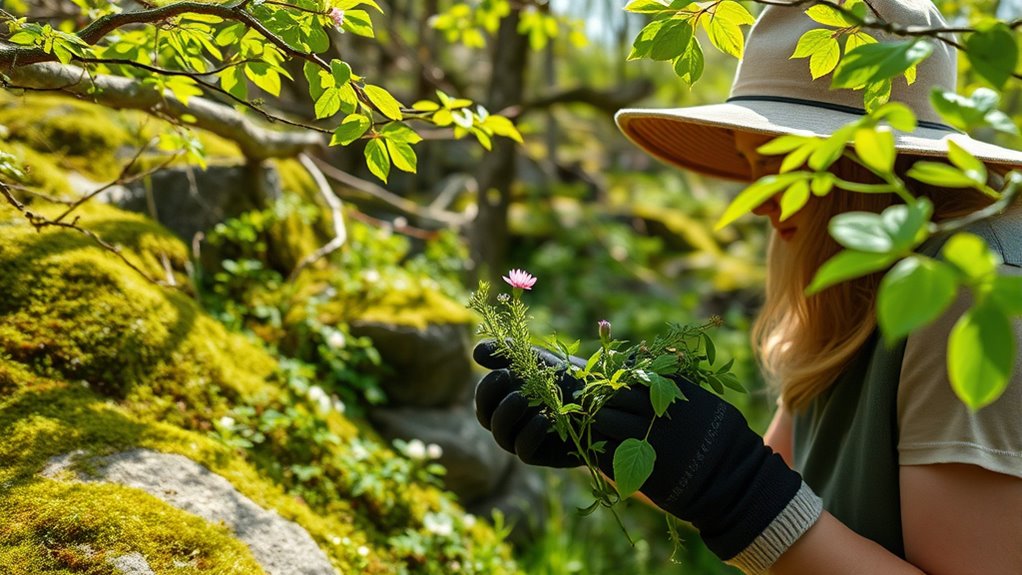
Practicing responsible foraging guarantees that you gather medicinal plants sustainably and safely. Prioritize foraging safety by verifying plant identification with multiple reliable sources to avoid toxic look-alikes. Harvest only what you need, taking small portions from each plant to support plant sustainability and ensure populations remain healthy. Always harvest responsibly by using clean, sharp tools and proper techniques that minimize damage and promote regrowth. Be aware of local regulations and land permissions to stay within legal boundaries and respect landowners’ rights. Avoid collecting endangered, protected, or rare species, supporting conservation efforts. Ethical foraging involves respecting the environment and participating in sustainable practices, so you can enjoy wild foods without harming ecosystems. Following these tips ensures a safe, respectful, and eco-friendly foraging experience.
Resources for Learning and Connecting With Nature
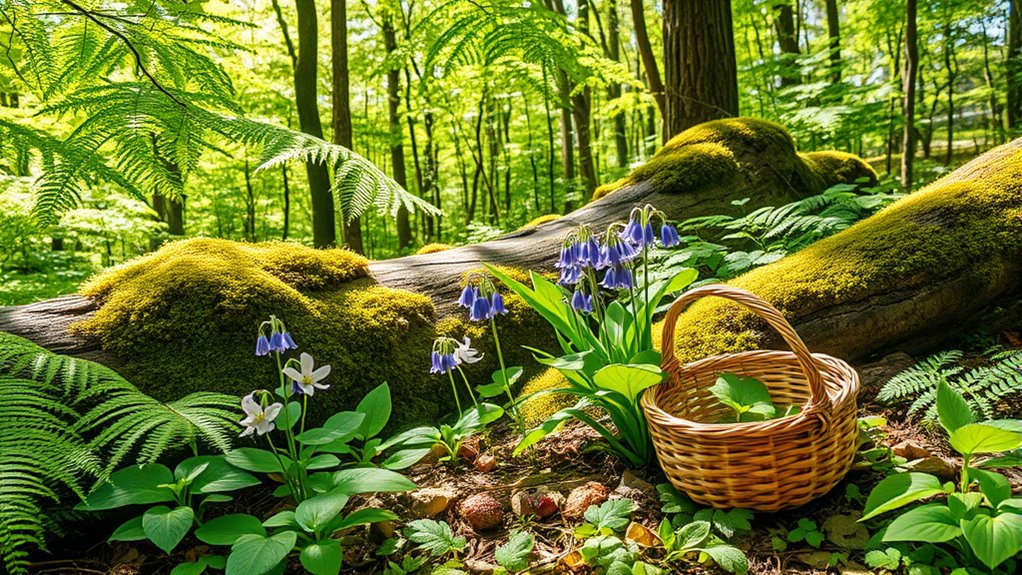
Connecting with nature and expanding your foraging knowledge is easier than ever thanks to a variety of resources. Whether you’re just starting out or looking to refine your skills, these tools help you identify wild edible plants confidently and practice sustainable harvesting. You can explore:
- Foraging resources like regional guides and plant identification apps
- Online foraging courses such as “Foraging North America” or “Wild Food Foraging”
- Community workshops and local botanical societies for hands-on learning
- Reputable blogs and social media accounts focused on wild food and herbal education
- Regional herbariums, university extension programs, and conservation groups offering expert guidance
These resources deepen your understanding, foster a stronger nature connection, and support responsible foraging practices. Use them to build confidence and enjoy the rich bounty of spring.
Frequently Asked Questions
What Is the Best Spring Forage?
You’re asking about the best spring forage, and it’s all about seasonal abundance. You can gather early greens like chickweed, violets, and wild onions, which are easy to identify. Edible invasive plants like garlic mustard help control their spread while offering nutrition. Don’t forget seasonal mushrooms like morels and oyster mushrooms, plus underground roots like dandelion and trout lily for culinary and medicinal uses. You can also tap trees for sap to make syrup.
What Is the Golden Rule of Foraging?
Did you know that misidentifying a plant can be deadly? The golden rule of foraging is to positively identify every plant or mushroom before harvesting. You need to be 100% sure it’s safe, avoiding toxic look-alikes. Always harvest sustainably, take only what you need, and respect local rules. Educate yourself constantly with trusted guides, and never forage in polluted areas or private property without permission.
What Is the 1 3 Rule for Foraging?
The 1 3 Rule for foraging says you should only harvest no more than one-third of any wild plant or mushroom. This way, you help guarantee the plant can grow back and stay healthy. You should always identify plants correctly and harvest responsibly, even when following this rule. By doing so, you protect ecosystems, support wildlife, and keep foraging sustainable for the future.
What Time of the Year Is Best to Forage?
You’re wondering when the best time to forage is. Generally, early spring from March to May is ideal, as wild greens, mushrooms, and early bloomers are tender and nutrient-rich. Keep an eye on local cues like blooming flowers and mushroom emergence. Timing varies by region, so consider your climate. Foraging now guarantees you gather the freshest, most flavorful, and sustainable wild edibles before they become woody or bitter.
Conclusion
As you venture into spring’s bounty, remember that foraging is like uncovering nature’s hidden treasures. Respect the land, harvest responsibly, and enjoy the thrill of discovering fresh greens, mushrooms, and flowers. Connecting with wild foods awakens your senses and nourishes your body. So step outside with curiosity and care—spring’s abundance awaits, ready to be a feast for both your palate and your soul. Happy foraging!

